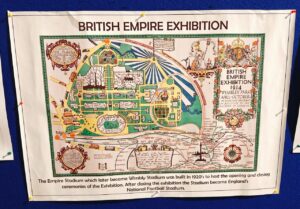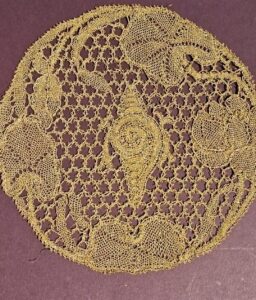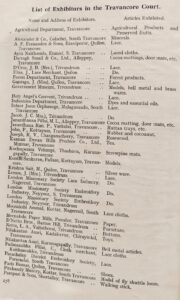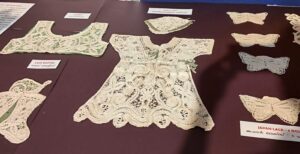A century later, a remarkable chapter in Kerala's history is being relived at the Napier Museum in Thiruvananthapuram.
Published Nov 30, 2024 | 9:00 AM ⚊ Updated Dec 05, 2024 | 7:49 AM

A golden embroidery table mat, depicting Travancore's coat of arms, displayed at BEE 1924.
In 1924, the princely state of Travancore embarked on an extraordinary voyage to Wembley, London.
The heritage of the princely state would be on display at the British Empire Exhibition (BEE) or the Great Exhibition of 1924, inaugurated on the turf of the then-newly created Wembley Stadium by King George V.
A century later, that remarkable chapter of Kerala is being relived at the Napier Museum in Thiruvananthapuram in an exhibition that makes one feel like one has stepped into a time machine.
The opulence of Travancore as showcased in the BEE — a trade fair that became a spectacle of colonial pride, attracting 27 million visitors over two years – is recreated, on a far diminished scale.
Among the treasures displayed in Thiruvananthapuram were artifacts once painstakingly curated and escorted to London by Dr. N Kunjan Pillai, who was director of Agriculture and Fisheries, and also the president of the Developmental Board.
Dr Pillai not only safeguarded these treasures but also served as a storyteller, introducing millions of visitors to the grandeur of his homeland.
The BEE was no ordinary exhibition. Spanning 216 acres, it featured princely states like Travancore, showcasing their rich culture and craftsmanship alongside industrial marvels.
There were exhibits at the BEE from across the British Empire, including Canada and Australia.
The sprawling venue later became Wembley Stadium — an iconic landmark of modern sports and culture, famously called “the Cathedral of Football” by football legend Pelé.
Originally planned for demolition after the exhibition, the site instead evolved into one of the world’s most celebrated sporting arenas.
Considered a successor to the Great Exhibition of 1851, the BEE eyed to bring together the dominions, colonies, mandates, and protectorates of the British empire.

BEE
The aim was to display their common interests and cooperation, to promote their industries and produce, and to encourage imperial trade.
The exhibition opened on St. George’s Day, 23 April 1924, and ran for two seasons, attracting over 27 million visitors.
Delayed by the First World War, the exhibition had been in planning since the early 1900s, with the British government funding half of the £2.2 million costs.
The BEE aimed to highlight the empire’s economic potential, foster inter-imperial trade, and promote British industrial leadership.
Pavilions from across the dominions and colonies displayed raw materials, handicrafts, and manufactured goods, alongside cultural programmes and conferences.
Iconic attractions included the India Pavilion, modeled on the Taj Mahal and Jama Masjid, and the Ceylon Pavilion, inspired by the Temple of the Tooth, which houses the relic of the tooth of Buddha, in Kandy.
While Britain emphasised its engineering, textiles, and chemicals, the exhibition also highlighted the empire’s “civilizing” efforts, with live demonstrations by African artisans.
However, its traditionalist approach to design faced criticism, overshadowing progressive trends in modern art and industry.
Despite its grandeur, the exhibition closed in 1925 with a financial loss of £1.5 million, reflecting shifting views of empire in the interwar years.
Going by the records of the Travancore Legislative Council (TLC), it was in 1922 that the then government decided to participate in the BEE “after a careful consideration” and communicated its decision to the erstwhile Madras Government.

One of the exhibits at BEE 1924.
In the Budget 1922, the government also allocated a sum of ₹5,000 towards this in the budget estimate.
As a prelude to the BEE, a preliminary exhibition was conducted from 5-20 October 1923 in Thiruvananthapuram.
The outcome of this has been stated by R Krishna Pillai, then chief secretary, in January 1924: “It is hardly necessary to mention that it was pronounced a great success and that it was a great eye-opener in respect of the large scope that exists for building up important industries in the country and trade with the outside world in a variety of articles, among which finished products play a prominent part.”
“A final selection of the exhibits was made by the exhibition committee and the selected articles have been packed, insured, and shipped to England,” he noted.
It was then estimated that the expenditure on account of the BEE was ₹34,566.
The main object of the participation of Travancore in this Exhibition was “to secure adequate advertisement for her goods and to find fresh markets for them by the establishment of business relations with foreign countries.”
Travancore’s participation in the BEE was met with criticism from various quarters, including the Travancore Legislative Council.

An excerpt of the list of exhibitors at BEE 1924.
MR Madhava Varrier, a member, questioned the tangible benefits of Travancore’s participation in the BEE, dismissing it as an expensive and fruitless endeavor.
He argued that claims about boosting industries and commerce were unsubstantiated and labeled the exhibition a mere “fashionable entertainment” for England.
Highlighting the financial strain, he stressed that spending a lakh of rupees on an event unlikely to yield material or industrial progress was an unjustifiable waste of resources.
According to A. Hoogewerf, another member, there is a lack of clarity on how the exhibition would benefit Travancore’s industries, warning against using it as a mere platform to showcase raw materials like tapioca, which could invite foreign exploitation.
He emphasised the need for concrete outcomes, calling on Dr. Kunjan Pillai to go beyond being a passive presenter and actively champion industrial growth.
With Travancore already lagging in industrial development despite significant spending, Hoogewerf urged the government to maximise the opportunity and ensure meaningful results from this costly participation.
Despite the criticism, Travancore attended the BEE, and a range of products were exhibited by government and private agencies.
The catalogue stated that in the Travancore Court, food products like farinaceous products (E.g. tapioca, dried chips of banana), preserved fish, vegetables, and fruits (E.g. Cashew nut, ginger in syrup), condiments and relishes (E.g. Ginger, turmeric), tea (Kanan Devan), minerals, timber, and other forest products, textile plants, textiles (laced clothes, coir mattings), lace embroidery and trimmings, boots, and shoes, perfumery, and others were on display.
The Travancore Court exhibition showcases a rich array of the princely state’s finest products, each a testament to the region’s cultural heritage and craftsmanship.

Lace exhibited in the BEE 1924.
It offered the visitors the craftsmanship behind coir yarn, spun by hand into durable mats and matting. The coconut palm’s versatility shines through its wide range of products like copra, oil, and fibre — essential to the region’s global trade.
A century-old temple car and intricately carved wooden cabinets were on display, each telling a story of skilled artistry in wood.
Then comes the opportunity to discover the staple roots of Travancore — cassava, arrowroot, yams, and sweet potato — cultivated for both daily use and preservation.
Once a cottage industry among Christian fisherwomen, Travancore lace had grown into a celebrated craft, earning accolades at European exhibitions. The exhibits offered the opportunity to explore intricate lacework that rivaled the finest French designs.
Exquisite ivory carvings drew many visitors, who viewed a craft perfected in Travancore over generations.
While Travancore was said to be the last pavilion, another princely state, Cochin, took part in the BEE and exhibited its products in the Madras Pavilion.
Going by an address made by then Dewan T Raghaviah on March 1925 before the Sri Mulam Popular Assembly, the participation was a success as thousands of visitors, who came not only from Great Britain and Ireland but also from various other countries in Europe and America, and from the Overseas Dominions, “have carried away with them a favourable impression of our country’s products, both raw and finished and of its resources.”
The Dewan said several inquiries had been received by Dr Kunjan Pillai from business firms in Great Britain, Canada, Australia, France, Italy, Germany, Belgium, Holland, and the United States of America, concerning the chief products of Travancore, such as copra, coir mats and mattings, tea, rubber, timber, oil-seeds and tubers.
He said Dr Kunjan Pillai would put the merchants of this country in touch with these firms.
“From the investigations made by him, he is satisfied that there is ample scope for the extension of our trade in the articles specified above, as well as in spices, ivory, works of art, lace and embroidery, and bell-metal ware. There is also great scope for business in preserved fruits and starch foods if we can produce them. There are considerable facilities for starting these new industries, and Dr. Kunjan Pillai has secured plans and estimates for the necessary equipment,” said the Dewan.
He concluded, “The openings are vast and the scope for expansion is unlimited, and the measure of the benefits that can be derived from our participation in this great Exhibition will be proportionate to the readiness with which our people take advantage of these opportunities.”
As per the India Catalogue on British Empire Exhibition 1924, the India Pavilion, inspired by the architectural styles of the Jama Masjid in Delhi and the Taj Mahal in Agra, featured 27 courts showcasing a variety of products alongside an exhibition of Indian art.
It stood as a magnificent testament to the grandeur of Mughal architecture, blending historical inspiration with artistic mastery.
Three large arched gateways on the North, South, and East sides led to galleries showcasing the cultural and artistic treasures of India’s provinces and princely states.
“The East gateway, serving as the Main Entrance, is a masterpiece in itself, featuring a gallery and balustrade topped with lotus-shaped minarets and a central dome reminiscent of the Taj Mahal,” the catalogue stated.
A document from the National Archives, the official archive and publisher for the UK Government, and for England and Wales, however, stated that the organisation of the displays sparked considerable debate and disagreement, especially against the backdrop of growing anti-colonial sentiment in parts of the empire.
Indian nationalists called for a boycott of the exhibition, leading to the resignation of two out of four Indian members of the exhibition’s executive council in India.
(Edited by Rosamma Thomas).
